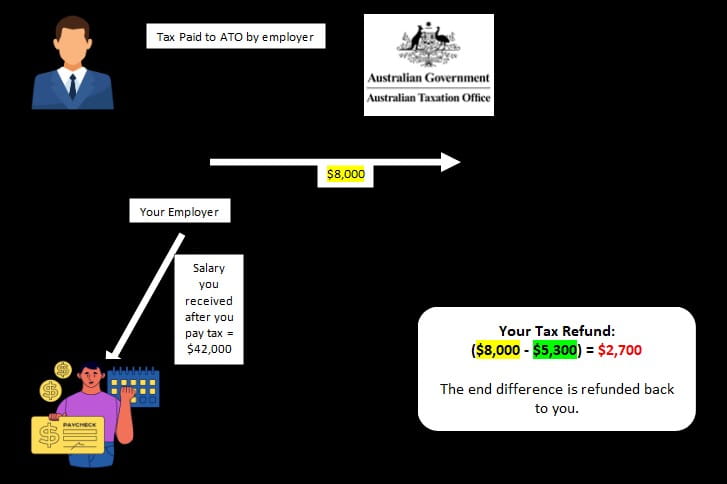Mohammad Wasimi is a senior learning facilitator at Torrens University. Before joining the university, he worked at several public accounting firms in the taxation area. He holds a bachelor's and master's degree in Accounting. Currently, he is pursuing his PhD in the area of Management Accounting. His research interests include the behavioural impact of management control systems, incentive, and compensation scheme design.
He covered topics on:
- How to obtain a tax file number (TFN)
- How to file a tax return
- How to claim Goods and Services Tax (GST) back
- How to claim funds in your Superannuation Account
- 2024 tax update
1. How to obtain a tax file number (TFN)
What is a tax file number (TFN)?
In Australia, a tax file number (TFN) is a unique nine-digit identifier issued by the Australian Taxation Office (ATO) to individuals for tax purposes. The TFN is used to identify any tax reports or reports related to tax returns or superannuation
Do I need a TFN?
- If you work as an employee for any organisation, most likely you are going to need a TFN
- If you have a bank account that pays you interest, you will be asked to provide a TFN.
It is important to keep your TFN secure and not share it with anyone unless it is necessary, as it can be used for identity theft or fraud.
How do I get a tax file number?
It’s free to apply for a TFN. There are two ways you can create your TFN:
- Use MyGovID. If you do not have a MyGovID, you can set one up through their website
- Use ATO’s website
When you go to ATO’s website, there are different options for different types of individuals in terms of applying for a TFN.
Australian residents and citizens can apply through the first two links. For international students, the third link is more suitable.
You need to provide information about your personal information such as passport details, visa details, address etc. to complete your application. Once completed, you will receive your TFN in 28 days or sooner.
2. How to file a tax return
What is a tax return?
A tax return is a form that you need to complete after the end of the financial year. In Australia, the financial year begins on 1st July and ends on 30th June of the following year. At the end of the financial year, you have a few more months to complete your tax returns.
Tax returns are generally due by 31st October
Do I need to lodge a tax return?
- If you have foreign, business, or investment income, you are required to lodge a tax return.
- If any tax had been taken out (withheld) from the income you receive. If you have been working for an organisation and your employer is paying tax on your behalf, you will most likely have to lodge a tax return.
In many cases, you can get some money back by lodging your tax return.
How do I complete a tax return?
Lodge your tax return online with MyTax, on your own or via a registered tax agent.
MyTax is a pathway provided by the ATO to submit tax returns and is the fastest way to process a tax return. Generally, you get your refund back within 2 weeks.
The difference here is that if you ask a registered tax agent to lodge your tax return, you are expected to pay for their services whereas doing your own tax return, there is no cost for service on MyTax.
To be able to go to your MyTax account, you need to use your MyGov ID.
Once you are in your MyTax account, much of the information concerning your tax return is self-populated as an auto-fail function. This means you may need to add more information before you can get your refund done.
3. How do tax returns work?
When you work with your employer, they would either pay you weekly or fortnightly. Before they pay you your salary, they will take a part of it for tax purposes and pass it on to the ATO on your behalf. The remaining salary is then paid to you. This is the amount you see that you receive in your bank account.
Let’s imagine that your annual salary is $50,000 and a year has passed for when you need to do your tax return.

When starting to do your tax returns, you must provide ATO with the following information:

*Deductions are the expenses you can claim that you have paid for your work.
Once the ATO knows what your taxable income is, they will calculate the amount of tax you are liable to pay. They have a rate in their report that they apply to determine the amount of tax you are to pay.

*Tax Offset is provided by the ATO if your income falls under the low-income category where they give you some kind of relief.
*Medicare Levy is the services the taxpayer receives from Medicare so they charge will charge you an extra amount for that.
Two things that can play a huge difference in the amount of money that gets refunded back to you are:
- Deductions that you can claim
- Medicare levy
4. What are deductions on a tax return?
What are deductions?
Most are work-related expenses that you pay for which can be claimed as deductions in your tax return.
Rules to claim deductions:
- You must have spent the money yourself and weren't reimbursed.
- The expenses must directly relate to earning your income.
- You must have a record to prove it (usually a receipt).
5. What is the Medicare levy?
This point is important for international students as they do not get Medicare benefits, but they are entitled to claim Medicare Levy Exemption.
Can I claim Medicare levy exemption?
If you are not entitled to Medicare benefits, you do not need to pay the Medicare Levy when you complete your tax return.
You will need to apply for the Medicare levy exemption on Services Australia or through MyGov. When you submit a claim for this exemption, you will receive a certificate that you can present as evidence when you complete your Tax Return and get a higher refund back.
6. What is the Goods and Services Tax (GST)?
Goods and Services Tax (GST) is a broad-based tax of 10% on most goods, services and other items sold or consumed in Australia.
As an International Student or traveller from outside of Australia, you can claim the GST you have paid back for some items under certain terms and conditions.
Can I claim GST for goods bought in Australia but taken overseas?
You can claim if:
- You spend at least AUD 300, (including Goods and Services Tax (GST), in total from a supplier with the same Australian Business Number (ABN)
- You buy the goods within 60 days of departure
- You need to declare the product if you bring it back to Australia
You can learn more about this GST refund scheme, also known as the Tourist Refund Scheme (TRS), from the Australian Border Force Website.
7. What is Superannuation?
Superannuation is a retirement saving scheme. It is money put aside by your employer over your working life for you to live on when you retire from work.
Compulsory contribution is made by the employer on behalf of their employee at a rate of 10.5% (current as at 2023).

People can have access to their superfund after 60 years of age.
But if you are planning to leave Australia permanently and do not have any other visas to stay for longer, then you can claim all the amount saved in your superfund.
For more information on how to claim your super as an international student or someone on a visa with temporary residence, you can go through the ATO website.
8. 2024 tax update
Starting from 1 July 2024, Australia will introduce updated individual income tax rates and thresholds. These changes, announced by the government on 25 January 2024 and recently enacted, include reductions in tax rates. For the latest information, please refer to the official Australian Taxation Office website.The information provided as part of this document is general in nature and is not to be considered or relied upon as financial or tax advice. It is to be used for educational purposes only.





